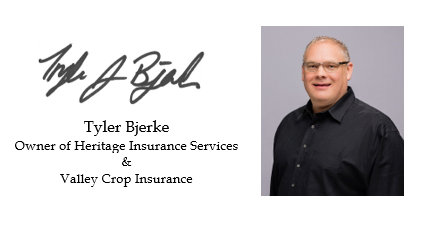From The President’s Desk

In preparation for a cool wet spring the office has been diligently preparing for the worst and hoping for the best. Although, we did not anticipate this kind of wet across the state we are certainly prepared for it.
We have eligibility reports by crop by county for all insureds available at your request. This may aid in your planting plan. If you wish to have your copy or just want to know what your eligibly looks like, please ask your agent and we will have a report emailed to you ASAP.
We have also been lobbying hard for RMA to remove the penalty in the late plant period for any insured that wishes to plant a crop. We were in Kansas City stating our case as well as working with Senators Hoeven and Cramer on this issue. We hope that we can convince them to see it our way and pressure RMA. We feel it is much better to plant at these prices if we have the option and removing the penalty would be a small incentive to do so.
As the final plant date for corn approaches (May 20-May 31 depending on your county) I wanted to get some refresher information on prevent plant.
The formula for prevent plant is your (mpci coverage level X APH X.55 or .60 if you bought up) X spring price of $5.90. There is no fall price associated with prevent plant
(140x.75)*.60)x$5.90=$371.70/acre
- You may plant past the final plant. This period is called the “late plant period” which extends 25 days past your final plant date for the county. By planting in this period, you will give up 1% coverage for everyday you are past the final plant date.
- You must report your prevent plant acres within 72 hours after the final plant date, if you do not intend to plant the insured crop during the late plant period
- No change in order to qualify for prevent plant, acreage must constitute 20 acres or 20% of the applicable unit
- The maximum number of eligible acres for prevent plant by crop by county is determined by the greatest number of acres planted or prevented from planting in the recent most 4 years (2018-2021)
Items that are new for prevent plant since our last statewide issue
- They have eliminated the two-crop history requirement. This will allow you to try and plant soybeans once the ground is fit and still be able to call the rest of the unit corn if that was your original intention. The 20-20 rule by field will still apply in this situation. Must have 20 acres or 20% of each field prevented from planting in order to call it a different crop than is planted in the field.
- Cover crops can now be hayed, grazed, or cut prior to nov 1 with no penalty. Corn is not considered a cover crop. Any cover crop harvested for grain or seed will be subject to a penalty on your prevent plant payment of 65% or 100% of payment withheld.
Questions and answers the office has been getting
Q: I planted a cover crop during the late planting period of the crop for which I am claiming a prevented planting payment. Can I also enroll these acres in an NRCS program (e.g., EQIP) without impacting my prevented planting payment?
A: Yes, these acres may be enrolled in an NRCS program, such as EQIP and maintain prevented planting coverage. Normal cover crop procedures would apply.
Q: What type of documentation do I need to maintain for the cover crop planted on my prevented planting acreage to meet the requirements in the crop insurance policy?
A: Producers should maintain all documentation regarding recommendations from agricultural experts (cover crop selection, seeding rate, etc.) For example, documentation could include published materials from agricultural experts that are applicable for the area or an individual assessment from an agricultural expert for a specific cover crop management practice. Producers must be able to provide such documentation to their crop insurance company upon request.
We are still hoping for the best and will update you on any developments. Communication is key in these times so be sure to reach out to your agent with any questions.

